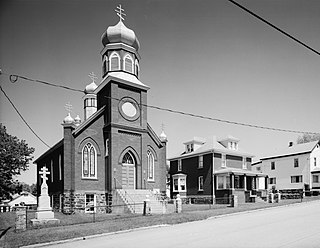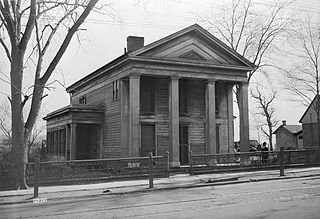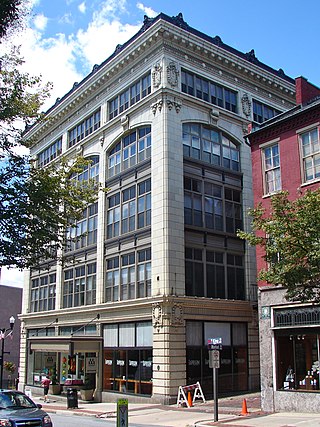
West Overton is located approximately 40 miles (64 km) southeast of Pittsburgh, in East Huntingdon Township, Westmoreland County, Pennsylvania, United States. It is on PA 819 between the towns of Mount Pleasant and Scottdale. Its latitude is 40.117N and its longitude is -79.564W.

The Philadelphia Quartermaster Depot, now known as the Defense Logistics Agency Troop Support, was founded as the Schuylkill Arsenal in 1799.

Railroad Terminal Historic District is a national historic district in Binghamton in Broome County, New York. The district includes 19 contributing buildings. Four of the buildings were directly related to Binghamton's rail passenger and freight operations, including the passenger station. Five buildings were built as warehouses, and ten were built to house retail activities with residential or office uses on the upper floors. The buildings were built between 1876 and 1910, with a major addition to one of them completed in 1932. This Delaware, Lackawanna and Western Railroad passenger station, with its Italian Renaissance campanile, was built in 1901. For most years of passenger service to Binghamton, Delaware and Hudson Railway and Erie Railroad trains used a different station 150 yards away.

The Harrison Avenue Bridge was a concrete deck arch bridge carrying Harrison Avenue in Scranton, Pennsylvania, United States.

The Old Mauch Chunk Historic District is a national historic district located at Jim Thorpe, Carbon County, Pennsylvania.

Alderson Historic District is a national historic district located at Alderson, Greenbrier County and Monroe County, West Virginia. The district encompasses 196 contributing buildings and three contributing sites located in the commercial district and surrounding residential section. They are predominantly 19th and early 20th century frame detached residences and masonry commercial buildings including notable examples of the Federal, Greek Revival, and Queen Anne styles. Notable buildings include the Woodson Mohler Grocery building, Johnson and Gwinn warehouse, Greenbrier Mill, First National Bank building, Alderson's Store, Chesapeake and Ohio depot, U.S. Post Office, and the City Hall (1939). The Alderson Ferry Site is for the ferry established 1789. Located in the district is the separately listed Alderson Bridge.

Central Trust Company Buildings are two historic commercial buildings located at Altoona, Blair County, Pennsylvania. They are two five-story buildings connected by a stair and elevator tower. The buildings measure 130 by 120 feet. The Central Trust Company Building was built in 1905 and is a white glazed brick building with brownstone trim in the Beaux Arts style. The entry features two Ionic order engaged granite columns. The adjoining Brett Building was built between 1922 and 1924.

Downtown Altoona Historic District is a national historic district located at Altoona, Blair County, Pennsylvania. The district includes 240 contributing buildings in the central business district and surrounding residential areas of Altoona. The buildings were primarily built after about 1860 and include residential, civic, social, and religious buildings. Although it does not encompass the entire downtown, it is for the most part the most urban part of Altoona's downtown district. Notable buildings include the Cathedral of the Blessed Sacrament (1920s), First Methodist Episcopal Church, First Presbyterian Church, First Evangelical Lutheran Church (1896-1897), U.S. Post Office (1931-1933), Fraternal Order of Eagles Building (demolished), Altoona City Hall, Casanave Building (1890s), Hutchison Block, McCrory's Department Store (1937), and Aaron-Penn Furniture Building. Located in the district are the separately listed Central Trust Company Buildings, Mishler Theatre, and Penn Alto Hotel.

Llyswen Historic District is a national historic district located at Altoona in Blair County, Pennsylvania, United States. The district includes 166 contributing buildings in a residential area of Altoona. The buildings are primarily single-family dwellings built between 1895 and 1940, and reflect a number of popular architectural styles including Colonial Revival and Queen Anne. Notable non-residential buildings include the Llyswen Methodist Episcopal Church, Ward Avenue United Presbyterian Church, Baker Elementary School and Llyswen Station.

The Saltsburg Historic District is a national historic district that is located in Saltsburg in Indiana County, Pennsylvania.

Colver Historic District is a national historic district located at Barr Township and Cambria Township in Cambria County, Pennsylvania. The district includes 336 contributing buildings, 5 contributing sites, and 3 contributing structures. The district consists of residential areas, coal mining resources, Cambria and Indiana Railroad shop buildings, and a dairy farm associated with the Ebensburg Coal Company's mine and developed between 1911 and 1943. Notable buildings include a variety of brick and frame workers' housing, the Ebensburg Coal Company office building (1914), stone company store (1912), Colver Amusement Company (1912), Colver Hotel (1912), Colver Presbyterian Church (1915), public school (1927), hospital (1914), Roundhouse No. 1 (1918), Roundhouse No. 2 (1920), and main power building (1911).

Windber Historic District is a national historic district located at Paint Borough, Scalp Level, and Windber in Cambria County and Somerset County, Pennsylvania. The district includes 944 contributing buildings and 1 contributing site. It encompasses an area first developed by the Berwind-White Coal Company in 1897, and developed and between 1897 and 1930. It includes the central business district of Windber and surrounding residential areas, consisting largely of workers' housing. Notable buildings include the Berwind-White Headquarters Building (1903), Eureka Department Store (1899), Windber Trust Company (1910), Windber Electric Building (1925), Clement Building (1902), Windber Hotel (1902), former train station (1916), Arcadia Theater (1919), Clubhouse (1899), David Shaffer House, and Windber Hospital.

Boswell Historic District is a national historic district located at Boswell in Somerset County, Pennsylvania. The district includes 90 contributing buildings and 1 contributing site. It encompasses an area developed by the Merchant's Mining Company of Baltimore, Maryland starting in 1901. It includes the remaining extant mine resources and the archaeological remains of the mine. They consist of utilitarian industrial buildings, four types of vernacular housing, and a variety of commercial, social, and institutional buildings. Notable buildings include the First National Bank of Boswell (1919), Merchant's Coal Company office (1901), St. Stanislaus Roman Catholic Church (1918), and Sts. Peter and Paul Russian Orthodox Church (1918).

The Silkman House is located at 2006 Main Ave., Scranton, Lackawanna County, Pennsylvania. Even though it is popularly known as the Providence Branch of the Scranton Public Library, it is currently used as the technical services department of the Lackawanna County Library System and is no longer open to the public.

Delaware, Lackawanna and Western Railroad Yard-Dickson Manufacturing Co. Site is a national historic district located in Scranton, Lackawanna County, Pennsylvania. It encompasses the Steamtown National Historic Site and Scranton Army Ammunition Plant and includes 16 contributing buildings, four contributing sites, and five contributing structures. The yard includes buildings and structures related to the yard's expansion in 1899-1939, and its usage as steam locomotive maintenance complex. The Dickson Manufacturing Company built steam locomotives, and the site of its works are included in this district.

Cassius Emlen Urban was a Lancaster, Pennsylvania-based architect. He was the leading architect in Lancaster from the 1890s to the 1920s.

The New Kensington Downtown Historic District, also known as the New Kensington Commercial and Residential Historic District, is a national historic district that is located in New Kensington, Westmoreland County, Pennsylvania.

The Vandergrift Historic District is a national historic district that is located in Vandergrift, Westmoreland County, Pennsylvania.

The West Chester Downtown Historic District is a national historic district that is located in West Chester, Chester County, Pennsylvania, United States.

Chester Springs Historic District, also known as The Old Art School, Orphan's School, Yellow Springs Spa, and Good News Buildings, is a national historic district located in West Pikeland Township, Chester County, Pennsylvania. The district includes 7 contributing buildings, 1 contributing site, and 1 contributing structure in the spa community of Chester Springs. The district includes the old hotel and inn, two large residences, a bath house at one end of the springs, and a studio. It also includes a wooden summer house that enclosed the iron springs. The property was the site of a hospital commissioned by the Continental Congress and built in 1777. The three-story, 106 feet by 36 feet wide building burned in 1902, was reconstructed, then burned again in the 1960s. The Yellow Springs resort operated in the early-mid 19th century and many of the buildings date from that period.
























